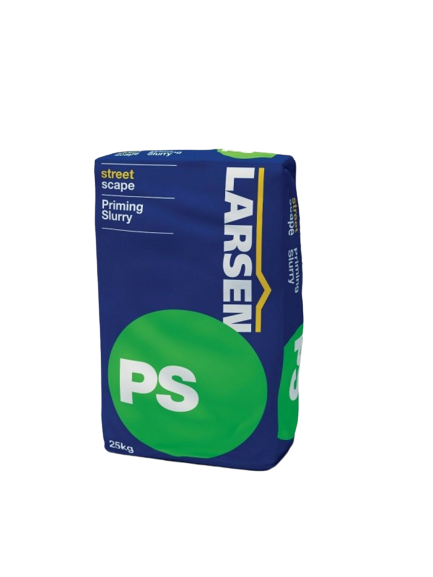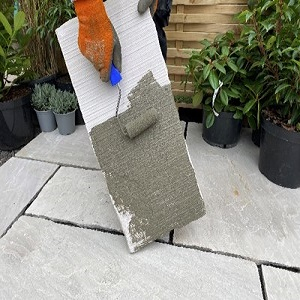Slurry Primer and Cement
When installing any patio area, it is very important that you use a slurry primer on the underside of the tile. Slurry primer are to be used on outdoor porcelain paving and many landscapers use slurry primer on Indian Sandstone too due to the improved bond bridge suction between the mortar bed and the paver.
The slurry primer offers an excellent level of adhesion and is a very important stage of any patio installation.
Speak to a member of our friendly sales team today on 01482 688008 or Email sales@meltonstone.co.uk
Slurry Primer
What is slurry primer and why do I need it?
Slurry primer, also known as bonding slurry or priming slurry, is a thin layer of cementitious material mixed with water that is applied to a substrate or base before installing tiles, paving stones, or other types of masonry materials. The purpose of using a slurry primer is to enhance adhesion between the substrate and the material being installed.
Here are a few reasons why you might consider using slurry primer:
1. Improved bond: Slurry primer helps create a strong bond between the substrate and the material being installed, such as tiles or paving stones. It fills in any irregularities or pores on the substrate surface, providing a better surface for the material to adhere to.
2. Reducing water absorption: Slurry primer can help reduce the absorbency of the substrate, particularly in cases where the substrate is highly porous or prone to moisture penetration. By applying a slurry primer, you create a barrier that minimizes water absorption, protecting the substrate and enhancing the bond.
3. Stabilizing the substrate: Slurry primer can help stabilize the substrate by providing a uniform surface and preventing differential movement between the substrate and the material being installed. This can be particularly important in situations where the substrate has uneven or weak areas.
4. Enhancing performance: Using a slurry primer can contribute to the long-term performance of the installation. It can reduce the risk of tile or paving stone movement, cracking, or delamination, ensuring a more durable and reliable result.
It's important to note that the need for slurry primer can depend on factors such as the type of material being installed, the characteristics of the substrate, and the manufacturer's recommendations. Different materials and substrates may have specific requirements regarding priming or bonding. Always refer to the manufacturer's guidelines or technical data sheets for the specific materials you are using, as they will provide the most accurate and reliable instructions for priming and installation.
Consulting with professionals, such as manufacturers, suppliers, or experienced installers, can also provide valuable guidance based on their expertise and knowledge of the specific materials and installation requirements.
Should I use priming slurry on sandstone pavers?
Using a priming slurry on sandstone pavers is not a common practice and is typically not necessary for standard installations. Sandstone pavers can generally be installed directly onto a suitable base or substrate without the use of a priming slurry. The natural texture and porosity of sandstone allow for good adhesion when using the appropriate installation methods.
However, there may be specific situations or circumstances where using a priming slurry on sandstone pavers could be beneficial. For example, if you are working with particularly smooth or non-porous sandstone, or if you are installing the pavers in vertical or overhead applications, a priming slurry might help enhance the bond and stability of the pavers.
If you are considering using a priming slurry on sandstone pavers, it is advisable to consult with the manufacturer or supplier of the sandstone pavers for their specific recommendations. They can provide guidance based on the characteristics of the sandstone and the installation requirements.
In general, proper surface preparation, including ensuring a clean and level substrate, is crucial for a successful sandstone paving installation. Following the manufacturer's guidelines, using the appropriate adhesive or mortar, and ensuring the pavers are installed with adequate joint spacing will contribute to a durable and visually appealing result.
Why you must use a priming slurry on the back of your paving stones.
Using a priming slurry on the back of paving stones is not a common practice or requirement in standard paving installations. In most cases, a priming slurry is applied to the substrate or base before laying the paving stones, not to the back of the stones themselves. The purpose of the priming slurry in this context is to enhance adhesion between the substrate and the paving stones.
However, there may be certain situations where applying a priming slurry on the back of paving stones could be beneficial. These situations are typically specific to unique installation requirements or materials. Here are a few scenarios where applying a priming slurry on the back of paving stones could be considered:
1. Unusually smooth or non-porous stones: If the paving stones have a very smooth or non-porous surface, it may be challenging for them to adhere to the mortar bed or adhesive. Applying a priming slurry to the back of such stones can help create a better bond between the stones and the mortar bed.
2. Vertical or overhead installations: In installations where the paving stones are used in vertical or overhead applications, such as feature walls or suspended pavements, applying a priming slurry on the back of the stones may help improve the bond and stability of the stones in these challenging orientations.
3. Unconventional materials: Some unconventional paving materials or custom-made stones may have specific requirements for adhesion. In these cases, the manufacturer or supplier of the paving stones may recommend or require the use of a priming slurry on the back of the stones to ensure proper adhesion and performance.
It's important to note that these situations are not common in typical paving installations. In standard horizontal paving installations with regular paving stones, applying a priming slurry on the back of the stones is not a standard practice. However, if you are working with specialized materials or specific installation requirements, it is advisable to consult with the manufacturer or supplier of the paving stones for their recommended installation guidelines and requirements.
Is slurry primer important for landscapers?
Slurry primer is an important tool for landscapers, especially when working with certain types of paving materials or in specific situations. Here are a few reasons why slurry primer may be beneficial for landscapers:
1. Enhancing bond and adhesion: Slurry primer is applied to the surface before laying the paving material and acts as a bonding agent. It helps improve the adhesion between the substrate and the paving material, ensuring a stronger bond. This is particularly useful when working with materials that may have lower inherent adhesion properties or when laying pavers on challenging surfaces.
2. Preventing efflorescence: Efflorescence is the white powdery substance that can appear on the surface of pavers due to the migration of salts within the material. Slurry primer can help reduce the risk of efflorescence by sealing the surface and preventing the migration of salts, ensuring a cleaner and more visually appealing paved area.
3. Stabilizing the substrate: In some cases, the substrate or base may have uneven or weak areas. Slurry primer can help stabilize the substrate by filling in gaps, cracks, or irregularities. This creates a more level and stable surface for the pavers, reducing the risk of shifting or settling over time.
While slurry primer can offer these benefits, it's important to note that it may not be necessary or suitable for all paving projects. The need for slurry primer can depend on factors such as the type of paving material, the condition of the substrate, and the specific requirements of the project.
As a landscaper, it's important to assess each project individually and consider factors such as the type of paving material being used, the condition of the substrate, and the recommendations of the manufacturer or supplier. Consult with professionals, such as manufacturers, suppliers, or experienced installers, who can provide guidance on whether slurry primer is necessary or beneficial for your specific project.
Can I make my own priming slurry?
Yes, you can make your own priming slurry for paving if you prefer to do so. However, it is not recommended as there are specific priming slurries that have different additives that create a more superior bond between the paving slab and the mortar bed.



